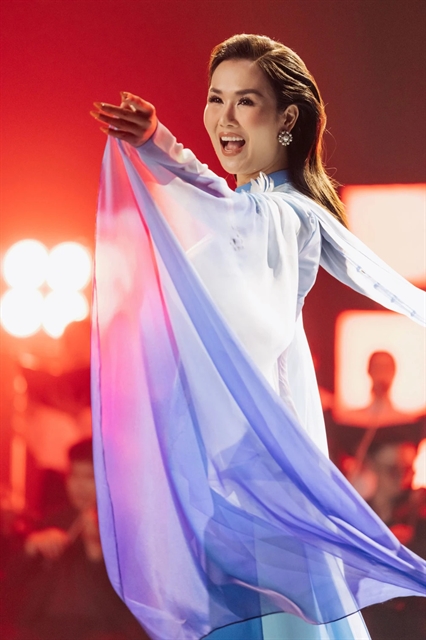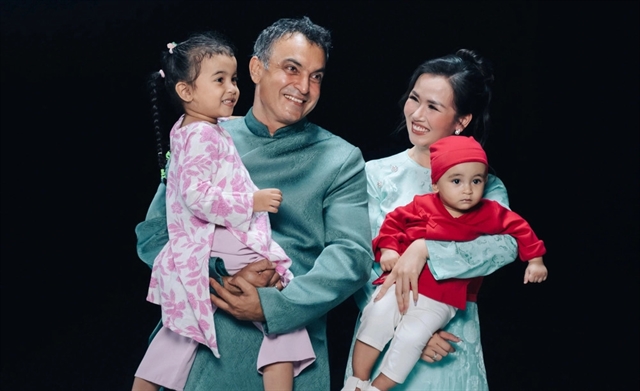Vietnamese singer Võ Hạ Trâm opens up about her latest music video Pledge to Be Vietnamese, her cross-cultural journey, and what it means to carry two homelands in her heart.

Singer Võ Hạ Trâm in the music video for 'I Vow to Be Vietnamese". Photos courtesy of the artist
Inner Sanctum: When you sing the words “I Vow to Be Vietnamese”, what emotions come to you?
That line is both an artistic vow and a proud civic declaration for me. It is not only the climax of the song but also the gathering point of all my emotions, beliefs, and love for my country that I have cherished for so long.
Performing this work, I don’t feel like I am just singing a song – I am sending a message: no matter where I am, and no matter what roles I play – as an artist, a wife, or a mother – I am always proud to be a child of Việt Nam.
That feeling intensified when I stood in front of a full symphony orchestra, wearing the traditional áo dài (long dress), surrounded by young artists and students, all Vietnamese of different generations, joining in a patriotic melody.
The most touching moment was when my husband (who is Indian) and our two children appeared backstage, also wearing áo dài, to cheer me on. It made me realise that Việt Nam is the root, the origin, and the place my heart will always return to.
So, the song is my quiet commitment – that in both art and life, I will always place national spirit at the forefront and live in a way worthy of the country that has nurtured me.
Inner Sanctum: In the final part of the song, you extend the name of the nation for over 15 seconds, which deeply moved audiences. What did you want listeners to feel at that moment?
That long note was one of the most emotional parts of the performance – not only for the audience but for me too. I sang with all my breath, emotions, and pride, as if compressing all my love for the nation into those sacred words.
The drawn-out sound symbolises a silk ribbon of peace stretching across the land – soft yet resilient, silent yet deeply touching.
I wanted listeners to truly feel the soul of the nation through every vibration of sound. Music may fade, but when it carries sincerity, it lingers in people’s hearts for a long time.

Singer Võ Hạ Trâm's husband and two children wearing áo dài backstage. Photo courtesy of the artist
Inner Sanctum: You have performed at many national celebrations. How do you see the role of music in such events?
Music is inseparable from the collective memory of a nation. Majestic, emotional melodies on occasions such as April 30 [Liberation of South Việt Nam] or September 2 [National Day] are not just ceremonial elements – they are invisible threads connecting generations, reminding us of our ancestors’ sacrifices, and reigniting patriotism in every heart.
For me, each time I sing on such occasions is a great honour, where art and civic duty intersect. The songs do not just echo in the hall but also resonate in the hearts of the people as a living voice of national pride.
Inner Sanctum: How do you choose songs for such events, and are there particular works that left you with lasting emotions?
Every traditional or patriotic song is like a journey back in time – a way for me to pay tribute and to understand and love my country more deeply.
For instance, Đất Nước Lời Ru (The Country in Lullabies) is, to me, a masterpiece in how music can narrate the nation’s story with poetic imagery.
When I performed Trăng Sáng Đôi Miền (The Moonlight over Two Regions), I felt like I was giving voice to the longing of countless Vietnamese during the time of division between North and South. The shared moonlight under one sky, yet separated by geography, embodies both lyrical beauty and historical pain. Singing that song filled me with profound gratitude for the generations who sacrificed so we could live today in peace and unity.
Inner Sanctum: What do you hope young people take away from the song?
I don’t want young people to listen to it as if it were a history lesson, but as a heartfelt whisper. From there, they can naturally and deeply nurture love for their homeland.
After the April 30 celebrations this year, I was surprised and touched to see young people embracing revolutionary and patriotic songs with a fresh spirit: listening but also remixing, covering, and spreading them widely on social media. It shows that as long as music resonates emotionally and with depth, young audiences are ready to receive it.
That’s why composer Đoàn Minh Quân and I arranged I Vow to Be Vietnamese with layered melodies – from quiet to climax, weaving symphonic and electronic elements. It is solemn yet modern, designed to open space for young listeners to interact with the song in their own way: singing it again, remixing, creating content, and sharing it.
I believe if music truly lives in young people’s daily lives – in the spirit of the times – then it won’t stop at its release moment but will endure in community memory and emotion.
Inner Sanctum: Your husband and children, dressed in áo dài, supported you on set. It was a moving image of Vietnamese identity in a globalised world. How do you feel about this?
My family is a special bridge between two cultures: India and Việt Nam. Seeing my husband and children wearing áo dài at the filming site was touching and also conveyed a message: being Vietnamese is also defined by love, connection, and cultural sharing.
In today’s globalised world, I Vow to Be Vietnamese can also be a declaration from hearts not born in Việt Nam but who love and cherish this land as their own homeland. VNS